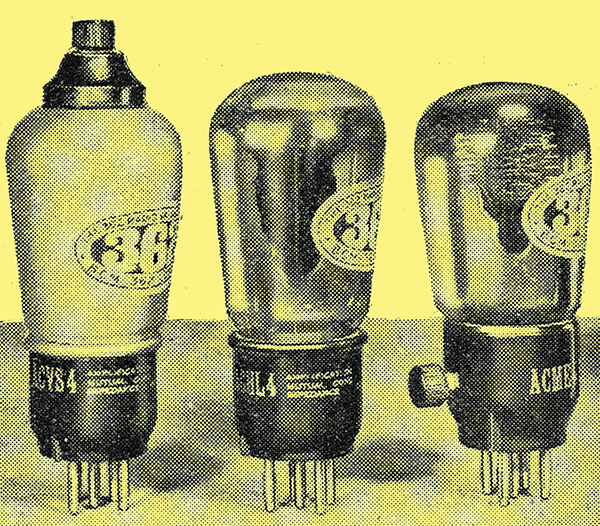|
A Range of Indirectly heated valves for AC Mains Operation

Selection of 362 AC mains valves.
The 362 Radio Valve C0., Ltd., Stoneham Works, Stoneham Road, Upper Clapton, London, E5, now market a very comprehensive range of valves for AC mains operation. The series includes screen- grid valves with and without variable-μ characteristics, a multi-electrode HF amplifier which comes within the category of an HF pentode, a general purpose triode, a power output triode, and a multi-electrode output valve of the pentode type.
The specimens that have been tested all show very good agreement with the maker's figures, and from an examination of the electrode assembly; there seems little likelihood of their characteristics changing by displacement of the electrodes, after leaving the works as they are of sturdy construction and well braced by mica bridge and spacing pieces. It is evident, also, that much care and attention is given to the assembly, in addition to which the workmanship is very good indeed.
The ACPX4, which is the triode power valve of this series, has an AC resistance of 2,030 Ω and a mutual conductance of 3.2 mA/Volt measured with 250 Volts HT and a grid bias of -15 Volts. It passes approximately 50 mA. in the anode circuit, so a bias resistor of 300 Ω will give the correct working conditions. The optimum working load for this valve is 3,000 Ω, and its price is 9s.
Tests were made also with the ACHL4, the AC general purpose triode, which has a rated AC resistance of 10,000 Ω, an amplification of 30, and a mutual conductance of 3 mA/Volt. Assuming these figures are for 100 volts HT and zero grid bias, our specimen proved slightly better than the standard, for its mutual conductance was 4.1 mA/Volt and its amplification 29.9, the AC resistance being, therefore, 7,300 Ω. Under working conditions, with 200 Volts HT and -3 Volts grid bias, the mutual conductance fell to 3 mA/Volt and the amplification to 21.9, but the AC resistance remained unchanged at 7,300 Ω. The anode current was just 12 mA. This valve costs 7s 6d.
The valves have proved very satisfactory in use, and the ACHL4 was further tested in the detector position of a short-wave set, where it gave extremely good results. The valve oscillates readily and is not microphonic.
The screen-grid type are metallised, and costs 12s. 6d. each, while, the price of the multi-electrode output model is 13s. All these valves are fitted with 4 Volt 1 Amp heaters.
|